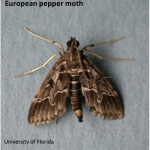 Composite list of known host plants for European Pepper Moth (pdf)
Composite list of known host plants for European Pepper Moth (pdf)
So far as known, this moth has been found in only one New Jersey greenhouse operation. However, it has been found in several greenhouses in the Mid-Atlantic area, in 2013 and 2014, and will likely become more widespread until growers become more aware of this pest. Dr. Stanton Gill, University of Maryland, is working on this insect.
The moths are small with about a ¾ inch wingspread and are active at night. If disturbed in daylight, the moths quickly fly a short distance and hide in foliage, easily escaping detection. The moths have an affinity for water and one trapping technique is to place a pheromone lure above a pan of water. We are currently testing the usefulness of a blacklight trap for detection and possible control of the moth.
EPM belongs to the same group of moths as European corn borer and the sod webworms. Like these species the larvae of EPM produces webbing at the soil line feeding on roots or on the stem. The larvae are often found in the soil in pots, but also underneath pots and trays or in the organic debris under these containers. This behavior of being in or under containers is one reason why chemical control is challenging. According to Dr. Gill a combination of applying Bt or spinosad while releasing biological control agents such as entomophagic nematodes or rove beetles may provide control of EPM. Rove beetles also feed on fungus gnats.
Cull piles could also be a source for moths infesting other greenhouses. If the cull piles were to be properly composted the insects would not survive.
The primary means of spread is through infested plant material although there is some indication that bark used in landscaping or as bedding material might also be infested. During warm weather EPM can infest outdoor plants. They are strong fliers and may move to nearby fields and greenhouses. However, EPM is not cold tolerant and is not likely to overwinter in New Jersey, unless it is in a heated greenhouse.
For additional information and description of the moths and larvae refer to the February 12, 2014, posting of the Plant and Pest Advisory on European pepper moth. The attached list of host plants includes herbaceous and woody plants, including evergreens. Anyone raising bedding plants, vegetables or ornamentals, may have to deal with this insect pest.

